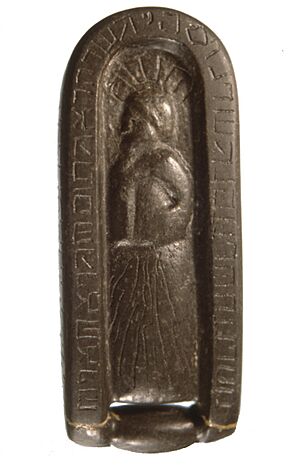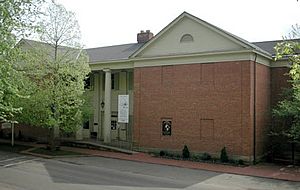Johnson-Humrickhouse Museum facts for kids
The Johnson-Humrickhouse Museum is a cool place to visit in Roscoe Village, a historic town in Coshocton, OH. This museum has lots of interesting things to see! It features four main exhibits spread across five galleries. You can explore Native American history, learn about Ohio's past, see beautiful Asian art, and discover decorative items from the 1800s and 1900s. The museum has more than 17,000 items in its collections, making it a treasure trove of history and culture.
Contents
Museum History: A Gift to Coshocton
The Johnson-Humrickhouse Museum exists thanks to two brothers, John and David Johnson. They grew up in Coshocton in the mid-1800s. As adults, they traveled all over the world. During their travels, they collected amazing objects from different cultures and regions.
When they passed away, they left their huge collection of over 15,000 items to their hometown. They asked that a museum be created to honor their parents, Joseph Johnson and Mary Susan Humrickhouse. The museum first opened its doors to the public on May 8, 1931.
The brothers' original collection included many fascinating things. There were Native American baskets and beadwork, ancient clay figures from Mexico, and beautiful Japanese ceramics. They also had Japanese woodblock prints and Samurai swords. From China, they collected lacquer ware, textiles, ceramics, and wood carvings. Plus, there were ceramics, glassware, and textiles from America and Europe. Since then, the museum's collections have grown even more. Many people have donated items, especially those related to local history and ancient Ohio Indian tools.
Exploring the Permanent Exhibits
The Johnson-Humrickhouse Museum has several exciting permanent exhibits. Each one offers a unique look into different cultures and times.
Native American Gallery: Ancient Tools and Art
The Native American gallery is full of ancient stone tools and arrowheads. These items belonged to Ohio's earliest people, including the Adena and Hopewell cultures. One very special display is the Rothenstein Cache. This is a collection of 342 stone blades found in 1963. A plumber discovered them while working on a house in Coshocton.
The blades were made from Coshocton black flint. They range from 2.5 to 8.5 inches long. These tools are about 2,000 years old and belonged to the Adena culture. The gallery also shows pottery, beadwork, carvings, and clothing. These items come from various Native American tribes from the 1700s, 1800s, and 1900s.
Historic Ohio: Pioneer Life and Advertising Art
This gallery lets you step back in time to early Ohio. It has a display that looks like a pioneer cabin. You can see the tools, furniture, and longrifles used by Ohio's first settlers. These items are from the late 1700s and 1800s. A main part of this gallery is a showcase of different longrifles. These include smooth bore flintlocks from the 1700s. There are also muzzle loaders, percussion cap, and breech loading rifles from the 1800s.
Did you know Coshocton is famous for advertising art? In 1886, a newspaper owner named Jasper Meek had a clever idea. He used his printing press to advertise a shoe store on burlap school bags. This was the start of advertising art! Many other companies followed his lead. Most of the early advertising was printed on metal trays and signs. Coca-Cola trays are some of the most common examples. It's believed that in the early 1900s, Coshocton had more artists than any city except New York City. Visitors can see Jasper Meek's old 1830 Washington Press. You can also view many examples of Coshocton's advertising art.
Golden Gallery: European and American Decorative Arts
The Golden Gallery features a cozy Victorian nook. Here, you can see European and American furniture from the 18th and 19th centuries. There are also beautiful textiles and decorative art pieces. Half of this gallery space is used for temporary displays. This means there's always something new to see!
Asian Gallery: Chinese and Japanese Treasures
This gallery showcases amazing Chinese and Japanese art from the 18th and 19th centuries. You'll find beautiful jade, porcelain, and cloisonné. There are also intricate embroideries and lacquer ware. The collection includes theater masks and detailed ivory and wood carvings. For those interested in warriors, there's even samurai armor and samurai swords!
Special Exhibit Gallery: Always Something New
Gallery five is dedicated to special exhibits. These displays change five times each year. The exhibits can be very different. They might feature modern quilts, fine art, or crafts. Sometimes, they show World War II posters or traveling exhibits from other museums. This means every visit can offer a new discovery!
The Newark Holy Stones: A Historical Mystery

The Johnson-Humrickhouse Museum is home to the original and famous Newark Holy Stones. These are four mysterious objects. They include the Keystone, the Decalogue Stone, a two-piece box for the Decalogue Stone, and a bowl. Both the Keystone and the Decalogue Stone have Hebrew writing on them. The Decalogue Stone also shows a picture of Moses.
These stones were found in the Newark earthworks in the 1860s. At first, people thought they might be linked to the ancient Hopewell Indian culture. This culture lived between 100 BC and 500 AD. However, most experts now believe the stones were made in the 1800s. Their exact origin is still a bit of a mystery!


